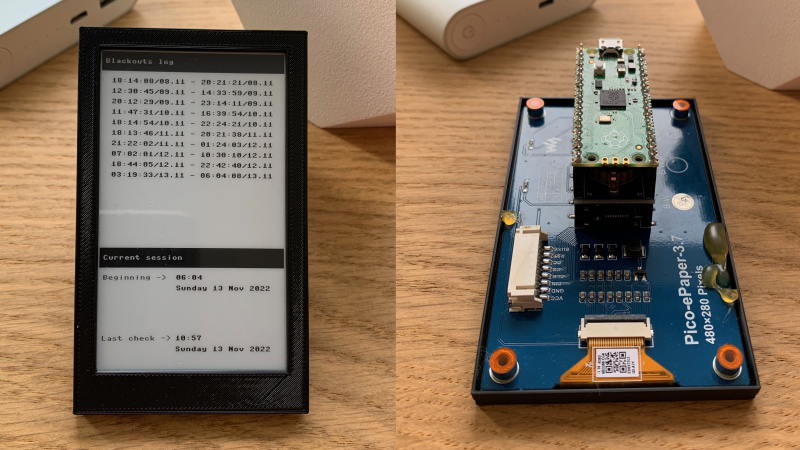[Dmytro Panin] lives in Kyiv, Ukraine where there have been rolling blackouts to stabilize the power grid. To help keep track of when the blackouts might happen, be they planned or emergency, and to get more information on how long the blackouts last, [Dmytro] has created a blackout logger.
The build consists of a Raspberry Pi Pico that connects to a DS3231 real time clock (RTC) with a Waveshare 3.7 inch eInk display which [Dmytro] puts into a custom 3D printed case. The RTC has it’s own small power supply, often times from a coin cell battery attached to the module, allowing it to keep time when the module and other devices attached to it are powered off.
The Raspberry Pi Pico is programmed to “poll” every 30 seconds, writing the current time to a file. Should the unit lose power, the last time, within a 30 second window, is available when power is restored and the unit wakes up again. Since the RTC has kept the current time, there is enough information to display the duration of the blackout. The eInk screen ensures that the information is readily available, even when there is no power.
War is not the only reason blackouts can occur and we’ve covered some issues with blackouts in Texas and California in the US.
















I lived in a student house where we had power cuts 3, 4 times a day, we had a list next to the switchpanel on which we wrote time/date and whether the big power users (laundry machine, dishwasher, oven and microwave) were on. The landlord claimed we used them all at the same time but it often occured with zero or one of these devices on, and we could convince him to rewire the house.
Would’ve been useful to have a device like this at the time!
Do not understand, other than for periods that no one is in the building, that this would produce usable data.
About 14 years ago, when I got my first solar install, made a power monitor. It measured cycle glitches, brown-outs, voltage surges and sags, frequency, and my inverter and generator outputs.
Most rural areas of Southern California do not have reliable power – and not just from fires, wind storms, and black-outs to ‘protect’ the grid. There have been some weeks, during benign weather and normal grid loads, where I have lost power for over five separate periods. Some intervals without grid power during these otherwise benign conditions have lasted for over ten minutes with no explanation forthcoming from the utilities.
In 2019, I wrote a formal specification and operator’s manual then sent my latest power monitor system to an accredited calibration facility (the associated costs of system verification and calibration are not for the feignt of heart). For about two years, I have made life miserable for the local utility.
If you are going to monitor power to your building, have a goal in mind and a way, at the minimum, to verify accuracy; or at least repeatability. Then use the data to screw with the morons that are running the grid.
please add mesh network working in blackout time
I programmed a Raspberry Pi to ping a search engine every minute and record if the internet was working. Since I have a lot of internet problems and my ISP says I don’t, this is proof that it’s out a lot.
Clever way to do this. Previously I’d use my ZigBee hub downtime alerts to measure this but I put that on a ups (also a good indicator but not perfect). I was going to write some code on a m5 stack to do this.
I’m slowly starting to develop the impressions that 90% of the world has lousy electrical power services.
Every day I seem to hear personal experiences of people from yet another place that tells me their power is as flaky as hell.
I wonder if that is an expanding trend or just people taking about it more.
The TVA (Tennessee Valley Authority) power grid which provides power to Tennessee, North Alabama, North Eastern Mississippi and a big chunk of Southern Kentucky is one of, if not the most reliable power grids in the USA. TVA is one of the alphabet organizations born out of the Roosevelt era New Deal to electrify the South US and to this day very rarely suffers deep brown outs much less outages. The rare times when they do occur power is usually restored within minutes. The southeast US may be backwards in many ways, but the quality of its mainly hydro and nuclear power grid interestingly is not.